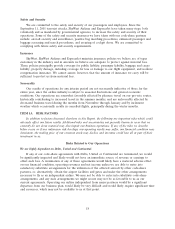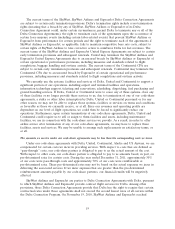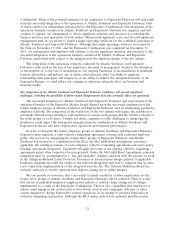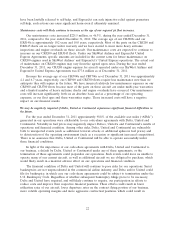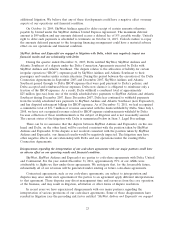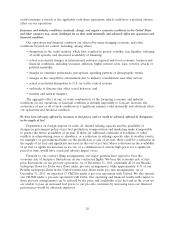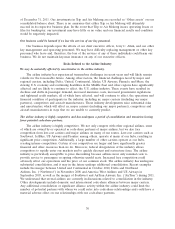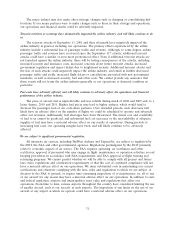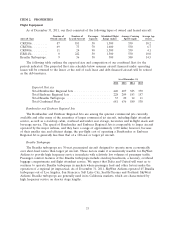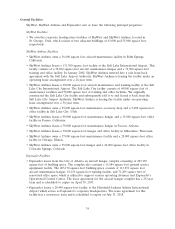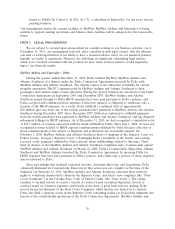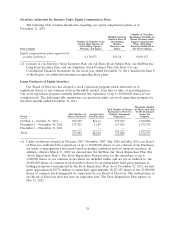SkyWest Airlines 2011 Annual Report Download - page 32
Download and view the complete annual report
Please find page 32 of the 2011 SkyWest Airlines annual report below. You can navigate through the pages in the report by either clicking on the pages listed below, or by using the keyword search tool below to find specific information within the annual report.in particular has reduced both the number of 50-seat regional jets within its network and the number of
regional airlines with which it contracts. There are currently more than 300 50-seat aircraft within the
Delta Connection system. In addition to reducing the number of 50-seat jets under contract, major
airlines have reduced the utilization of regional aircraft, thereby reducing the revenue paid to regional
airlines under capacity purchase agreements (See the risk factor titled ‘‘Reduced utilization levels of our
aircraft under our code-share agreements would adversely impact our financial results’’ for additional
details). This decrease had a negative impact on our regional airline services revenue and profitability.
Declining interest rates could have a negative effect on our financial results.
Our earnings are affected by changes in interest rates due to the amount of our variable rate
long-term debt and the amount of cash and securities we hold. Under our contractual arrangements
with our major partners, we are directly reimbursed for interest expense on debt-financed aircraft as a
pass-through cost. The reimbursement of the interest expense is recorded as passenger revenue in our
consolidated statement of income. Thus, a decline in interest expense associated with contract aircraft
would likely be offset by a reduced aircraft ownership cost passed through to our major partners.
Interest expense decreased $6.1 million, or 7.1%, during the year ended December 31, 2011, compared
to the year ended December 31, 2010. The decrease in interest expense was substantially due to a
decrease in interest rates and the majority of this reduction was passed through to our major partners.
Interest income decreased $6.1 million, or 42.7% during the year ended December 31, 2011, compared
to the year ended December 31, 2010. Interest income is not a component of our contractual
arrangement with our major partners. If interest rates were to decline, our major partners would
receive the principal benefit of the interest expense decline, since interest expense is generally passed
through to our major partners, however, if declining interest rates reduce our interest income, our
financial results will be negatively affected.
Our insurance costs have increased and further increases in insurance costs or reductions in coverage could
have an adverse impact on us.
We carry insurance for public liability, passenger liability, property damage and all-risk coverage
for damage to our aircraft. As a result of terrorist attacks occurring during recent years, aviation
insurers significantly reduced the amount of insurance coverage available to commercial air carriers for
liability to persons other than employees or passengers for claims resulting from acts of terrorism, war
or similar events (war-risk coverage). At the same time, these insurers significantly increased the
premiums for aviation insurance in general.
The U.S. government has agreed to provide commercial war-risk insurance for U.S.-based airlines
through 2012, covering losses to employees, passengers, third parties and aircraft. If the U.S.
government ceases to provide such insurance beyond that date, or reduces the coverage provided by
such insurance, we will attempt to purchase insurance coverage, likely with a narrower scope, from
commercial insurers at an additional cost. To the extent this coverage is not available at commercially
reasonable rates, we would be adversely affected.
While the price of commercial insurance has generally declined since the period immediately after
the 2001 terrorist attacks, in the event commercial insurance carriers further reduce the amount of
insurance coverage available to us, or significantly increase the cost of obtaining such coverage, we
would be adversely affected.
We could be adversely affected by an outbreak of a disease that affects travel behavior.
In 2010, there was an outbreak of the H1N1 flu virus which had an adverse impact throughout our
network. In 2003, there was an outbreak of Severe Acute Respiratory Syndrome (‘‘SARS’’), which had
an adverse impact on travel behavior. In addition, in the past there have been concerns about
28


